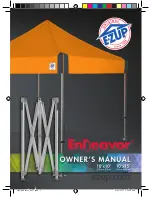
• For larger tents, (15x30 and larger)
frame tent jacks should be used to
raise the frame and install the leg poles
• Locate one of the long sides of the
frame—this will be raised first, while the
opposite side remains on the ground
•
Important
: Lift the entire side of the
frame at once (not one corner)—crank
jacks in unison
General rules are; work on the long side,
one side at a time, and
never
place jack in
the middle of a spreader bar
• Install all the legs on this side—secure
with ‘R’ pins
• Repeat for opposite side, then install
legs for the remaining two sides
•
Important:
tighten spring buckle straps—
for security and to help pull canopy
corners into place
Double check leg poles
—making sure
each pole is straight and lined up correctly,
while tent jacks are still handy
• Once the tent is vertical and all the leg
poles are attached, begin the process of
staking the tent—with plenty of hands
on deck, lift and adjust tent position if
needed, first
• Measure 4 ft. out from each leg pole and
place a stake in the ground
• Stakes should look uniform, around the
tent—and 6 inches above ground
see (
figure B
)
• Stakes should then be hand hammered
or for larger installs, use a stake driver
STEP 11. STAKE LINE
Leave 6 inches showing
Correct
Incorrect
STEP 10. INSTALLING LEGS
(15x30 and larger tents)
• Ground stakes should be hammered
in vertical, not angled
(sledge hammer required)
• Complete the hammering process by
driving the stakes in and leaving
6 inches showing
• Connection of ropes to ground stakes,
can be made with a few different secure
knots (see
figure C
, page 8) for one of
the more commonly used knots
FIGURE B. HAMMERING STAKES
Remember, base
plates should be
attached first
6˝
Stake Line
Ground
Stakes
Approx. 4 to 5ft.
from leg poles
4 ft.
4 ft.
7
20 x 40 example
716 832-TENT
(
8368
)






























